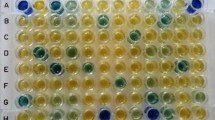Abstract
Six methods for the estimation of microbial biomass were compared for determination ofFrankia cell concentrations. Six strains ofFrankia were cultivated in stationary culture, harvested by centrifugation, washed with saline buffer and diluted to five standardized concentrations. These cell suspensions were then used to assess reliability of each of the biomass determination methods. The destructive total protein determination methods were the most sensitive and reliable. Two non-destructive methods, packed cell volume and turbidity measurement, were also accurate, and because of their simplicity hold advantage for routine growth measurements and inoculum dilutions. Dry weight determinations were inconsistent for the small cell masses used in this study. An ELISA procedure demonstrated reliability but little sensitivity.
Similar content being viewed by others
References
Baker D and Torrey J G 1979 The isolation and cultivation of actinomycetous root nodule endophytes.In Symbiotic Nitrogen Fixation in the Management of Temperate Forests. Eds. J C Gordon, C T Wheeler and D A Perry. pp 38–56. Oregon State University Forest Research Laboratory. Corvallis.
Bradford M M 1976 A rapid and sensitive method for the quantitation of microgram quantities of protein utilizing the principle of protein-dye binding. Anal. Biochem. 72, 248–254.
Burggraaf A J P and Shipton W A 1982 Estimates ofFrankia growth under various pH and temperature regimes. Plant and Soil 69, 135–147.
Dawson J O and Gibson A H 1987 Sensitivity of selectedFrankia isolates fromCasuarina, Allocasuarina and North American host plants to sodium chloride. Physiol. Plant. 70, 272–278.
Kishinevsky B D and Jones D G 1987 Enzyme-linked immunosorbent assay (ELISA) for the detection and identification ofRhizobium strains.In Symbiotic Nitrogen Fixation Technology. Ed. G H Elkan. pp 157–184. Marcel Dekker, Inc., New York.
Koch A L 1981 Growth Measurement.In Manual of Methods for General Bacteriology. Eds. P Gerhardt, R G E Murray, R N Costilow, E W Nester, W A Wood, N R Krieg and G B Phillips. pp 179–207. American Society for Microbiology, Washington, D.C.
Murry M A, Fontaine M S and Torrey J G 1984 Growth kinetics and nitrogenase induction inFrankia sp. HFPArI3 grown in batch culture. Plant and Soil 78, 61–78.
Smith P K, Krohn R I, Hermanson G T, Mallia A K, Gartner F H, Provenzano M D, Fujimoto E K, Goeke N M, Olson B J and Klenk D C 1985 Measurement of protein using bicinchoninic acid. Anal. Biochem. 150, 76–85.
Wright S F, J B Morton and Sworobuk J E 1987 Identification of a vesicular-arbuscular mycorrhizal fungus by using monoclonal antibodies in an Enzyme-Linked Immunosorbent Assay. Appl. Environ. Microbiol. 53, 2222–2225.
Author information
Authors and Affiliations
Rights and permissions
About this article
Cite this article
Nittayajarn, A., Baker, D.D. Methods for the quantification ofFrankia cell biomass. Plant Soil 118, 199–204 (1989). https://doi.org/10.1007/BF02232807
Issue Date:
DOI: https://doi.org/10.1007/BF02232807




